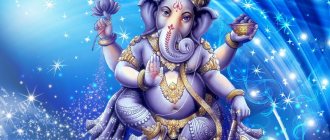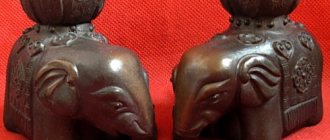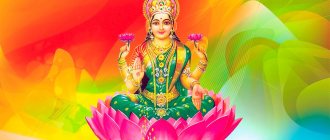History of origin
The Christian religion says that in the beginning was the Word. The Indian Vedas believe that in the beginning there was Sound. It was from him that the Universe was born. The entire Creation was contained in the vibration of OM. This mantra is like a hologram that contained countless worlds. More precisely, the Creator (in Hinduism he is called Brahman) manifested himself in the form of primordial sound, becoming the energy of creation.
Vedic texts say that the vibration of OM has no beginning and no end. It exists forever. Hindus believe that this is what God sounds like. This sacred sound was discovered by the ancient sages. While sitting in meditation, yogis discovered the original source of the Universe, and it was the universal sound OM. Perhaps this is how the mantra OM appeared. Yogis became convinced of its effectiveness and began to actively practice chanting it. We can say that it was the discovery of OM that marked the beginning of the use of mantras for meditation.
Types of mantras - what they are
There are three main types of mantras: bija (seed), saguna (with form) and nirguna (without form). Bija mantras can be used individually, but most often they are included in Saguna mantras to give them a special "seed" power. Bija mantras correspond to the 7 chakras and the main Hindu deities. Saguna mantras invoke the forms of individual deities or personalized aspects of God. The recitation of Saguna mantras is said to generate the actual form of a particular deity, thus manifesting its power. Nirguna mantras come from Vedic texts and are the oldest mantras of the three types. Since no deities or personalized aspects of God are associated with these mantras, they are very difficult to interpret and are believed to have no specific form or meaning. These mantras are said to be identified with all of creation and contain fundamental truths in yogic philosophy. It is said that the mind must be very strong to concentrate on abstract Nirguna mantras and therefore they are not recommended for beginning students.
Because each mantra invokes a specific power, they can be used for very specific purposes: spiritual development, healing from illness, and to achieve worldly desires. When combined with the user's intention, mantras can become even more focused and powerful. They say that mantras become stronger in direct proportion to the number of repetitions. The mantra gains full power by becoming “sedentary” in the heart after 125,000 repetitions, achieving what is called Mantra Siddhi.
The practice of repeating a mantra is considered the easiest form of meditation. Sitting in a comfortable position with eyes closed, repeat the mantra silently or loudly. Pay special attention to the speed and rhythm of your chanting, correct pronunciation, purpose and esoteric meaning of the mantra. Allow your mind to focus on the mantra, let go of thoughts and maintain a slow and deep breath. A mala (string of beads) can be used to count a series of 108 repetitions of a mantra. Like prayer and affirmation, repeated use of a mantra can have a powerful effect on the mind, body, spirit and emotions.
Mentally, mantra meditation increases concentration and improves memory. Physically, mantra meditation lowers heart rate, lowers blood pressure, and activates the relaxation response to enable healing and rejuvenation. Mantra meditation builds self-confidence and empowerment, reduces stress and balances emotions. Spiritual mantras are said to dissolve bad karma, produce jnana (wisdom) and are considered one of the many yogic paths to self-realization.
The sound of OM in various spiritual practices
The worship of the sound OM dates back to the times of the ancient Indian religion - Hinduism. Here it is revered as the most sacred sound. Any mantra or prayer begins with it. Hindus also believe that OM combines the wisdom of the three main Vedas - texts containing sacred knowledge.
Buddhists took the OM sign from the Hindu tradition and used it in their rituals. Buddhist monks in Tibet practice collective mantra chanting. The sound AUM for this religion has a sacred meaning; it embodies the triad Body - Speech - Mind of the Buddha. It also contains three Buddhist jewels: Buddha, Dharma (Teaching) and Sangha (Community).
Buddhist monks use the sound OM for meditation
Worshipers of the god Vishnu - Vaishnavas - consider AUM as the relationship between Vishnu, his wife Sri and the one who worships them. In the Hare Krishna tradition, the triad is interpreted as Krishna – Krishna Energy – All living beings.
OM NAMAH SHIVAYA is one of the central prayers of fans of Shiva, the god of destruction. In addition, Shaivites believe that the OM mantra contains the power of Shiva.
The sound OM-AUM is used by yogis for meditation and practices related to breathing (in particular, pranayama). AUM is pronounced in three stages, with attention distributed to different areas of the body. The pronunciation begins from the abdominal area (“A”), then rises to the chest (“U”) and ends at the top of the head (“M”), where it dissolves, merging with the Cosmos.
Meaning
There is no literal translation. In fact, the OM mantra, according to the Vedas, contains the entire Universe. This is the sound reflection of Divine energy. The mantra contains great knowledge that cannot be expressed in words. We can say that OM is the Absolute, the Supreme, the Creator. In other words, it is one of the names of the Supreme God.
The mantra has another sound option - AUM. This triad has many interpretations. We will give only part of the meanings of the mantra.
- AUM personifies the triad of the main Hindu gods, and in fact - the cycle of existence of the material world. Brahma creates the world, Vishnu is its preserver, and Shiva destroys it to begin a new cycle.
- Another meaning of the triad is the unity of three times - past, present and future. The Creator Himself lives in Eternity, that is, outside of time.
- There is also such an interpretation of AUM: Divine mind - the world of matter - individual consciousness. These are elements of Creation, closely related to each other.
- One can consider AUM as the equivalent of the famous spiritual formula “Sat-Chit-Ananda” (Eternity – Consciousness – Bliss).
- If we analyze the triad in the human aspect, then it means Body – Soul – Spirit.
Of course, these are not all interpretations of the OM-AUM mantra, but they give a general idea of the ambiguity of this sacred symbol.
Description of practice
OM can be used in two versions: passive and active.
Passive practice
The first method involves listening to audio recordings. There are many options available on the Internet. In particular, there is the chanting of Buddhist monks who follow an ancient tradition. Listen to several recordings and choose the one you like. Don't limit yourself to just one option, as morning, afternoon and evening meditation require different moods.
The main thing is to choose a secluded, quiet place where no one will distract you.
- The effectiveness of the practice largely depends on the position of the body in which the energy flows will not encounter obstacles. The simplified “Lotus” is suitable for a beginner. Sit on the mat, cross your legs in front of you, spreading your knees to the sides. Turn your hands up and place them on your knees. Relax as much as possible, but keep your back straight.
- Take three deep breaths, turn on the recording and close your eyes. Focus your attention on the place between the eyebrows, where the Ajna chakra, or “third eye,” is located.
- Turn off all thoughts and just listen to the chanting of the OM mantra. You must perceive it not only with your ears, but with your whole body. With the right attitude, every cell will begin to respond to this ancient vibration.
Just turn on and listen to the mantra OM:
Active method: using AUM
An active version of the practice involves chanting a mantra or pronunciation. The requirements for the environment and body position are the same as for listening. Don’t rush to master it, go from simple to complex:
- a mantra consists of three sounds. They smoothly flow from one to another. First, something like AAAOOO sounds. Then comes a drawn-out “Ooooh.” The syllable ends with a vibrating “Mmmmmmm.” It is pronounced with closed lips, as if through the nose. A large bell produces a similar vibration when struck. All attention is directed to the “third eye” zone;
- Begin your meditation by saying the syllable AUM in a whisper. Do three to nine reps. After this, you can begin to perform in full voice;
- Before singing, take a deep, calm breath and close your eyes. The mantra is pronounced as you exhale and lasts as long as possible - ideally 30 seconds or more. Don't try to chant OM too loudly. The main thing is that the vibration is felt by the body;
- take a breath, while mentally pronouncing the syllable AUM, try to hear this inner sound;
- As you exhale, chant the mantra out loud again.
Active method for advanced
After two weeks, you can supplement the practice with the following element:
- gradually reduce the volume of singing, but the voice should not be compressed;
- imagine that the mantra OM vibrates not only your body, but also the entire space around you. You can even imagine a large bell with vibrations coming from it;
- in the last stage you sing silently. Meditation becomes silent. AUM comes from the very depths of your being, and the vibrations spread throughout the entire Universe. This is a rather difficult part of the practice, so you can skip it. But if you successfully cope with this stage, you will be fully rewarded with an unusual mystical state.
During meditation, you will feel how the entire Universe is filled with sound.
At first, spend no more than 10 minutes meditating to avoid overload. Then the practice can be increased to 30–60 minutes.
In this video, Andrey Verba talks about the intricacies of the OM mantra:
How to easily perform a mantra
There are three ways to perform the mantra. One of them is loud singing. The next one is to mutter it under your breath in a very low voice so that only you can hear the mantra. Finally, you can simply repeat the mantra mentally. The last method is useful because you can use the mantra at any time, even while in public or doing work, without anyone noticing.
Some people who want to use the mantra in a more proper way can try a mala that has 108 beads. These beads correspond to the repetitions of the mantra so that you recite it at least 108 times. When you recite a mantra with a mala, you do so in any of three types. You can also set the amount of time, 10 or 20 minutes, and repeat the mantra without mala.
Singing has different effects because it vibrates inside and outside your body. Each method has its advantages, but all three are good.
The effect of OM-AUM practice
OM embodies the energy of Creation. This is a powerful force that contains a program of harmony and health. The benefits of the OM mantra are undeniable. Vibration puts the human energy system in order not only on the physical level, but also on subtle levels - emotional, mental, etheric.
When performing OM-AUM, the body and consciousness are cleansed of negative layers. It miraculously relieves emotional stress and calms the nervous system. With regular practice, physical illnesses will also recede. Of course, if you put your soul into meditation, and do not repeat the mantra mechanically.
Of course, you shouldn't expect instant results. Be patient and you will certainly feel the energy of light and love that comes from the center of the Universe and passes through your body. At the same time, all energy channels are restored and the cells of the body are healed. But the main effect is to cleanse the consciousness. The spiritual power of the OM mantra will rid the mind of dark thoughts and the heart of negative emotions. It's hard to believe, but over time your personality will change and become more harmonious. Thus, you will rise to a new stage of evolution.
After some time, the need for meditation will disappear. You can evoke the sound OM according to your intention in any environment and recharge yourself with energy from it. The body will vibrate on the same wavelength as the center of Creation. You will feel the unity of the Universe, its eternity and infinity.
The practice of chanting AUM will make life harmonious
By the way, the sound of OM can also be used to cleanse the room where you live. It is no less effective than prayed water or the flame of a wax candle. In a similar way, you can influence a thing to cleanse it of negative energy.
Divine mantra
There are literally thousands of deities in Eastern traditions, each associated with a different attribute, and each with a different mantra that evokes that attribute. For a Hindu, repeating one of these mantras would be a form of worship of this deity. However, for those less religiously inclined, deities and their attributes should be seen in their more subtle context as archetypal energies.
All of these energies are within you, either at rest or in a state of imbalance or balance. When they are inactive, you may be deficient in this area; when you are out of balance, you may experience some disturbances; and, being in balance, you can enjoy harmony and fulfillment.
By repeating one of these mantras, you can activate and harmonize its effects in all areas of your life.
Ganesha mantra
Ganesh Mantra is known for its ability to remove obstacles in our psychological and spiritual life.
This may not be the most common mantra, but like others of its kind, it is powerful. And with practice, you will notice its powerful benefits. Ganesh is the son of god Shiva and goddess Parvati and brother of Kartikeya. Parvati gave birth to Ganesha when she made him from pieces of clay from her body.
He is described as having a human body and the head of an elephant, with one tusk. Although the number of limbs he has varies according to legend, he is usually depicted with four arms, in which he carries a blow and a noose.
He's drawn with a big round belly - probably because he's carrying a bowl of dumplings!
While there are many stories about how Ganesh lost his fang, a favorite is that he was guarding his sleeping parents; Parashurama, unhappy with Ganesh for being denied entry to Mount Kailash, engaged him in battle.
Although Ganesh fought valiantly and was determined to win, Parashurama threw his ax at Ganesh's head, thereby breaking the fang. Ganesh took the blow without resistance because the ax was a gift from Shiva. When should you use Ganesh Mantra?
To make the best use of the Ganesha Mantra, use it when you are ready for a new beginning.
This could be a business deal, a new job, a new relationship, or even the start of a new personal project.
There are no set rules for chanting the Ganesha Mantra, but you can use it to bring about good luck, happiness, beauty and success in your life.
It is most effective when used to remove negativity and fear from your mind.
How to chant the Ganesha mantra
The Ganesh mantra is chanted like this:
OM GAM GANAPATAYE NAMAHA SHARANAM GANESHA
Energy Mantra
To calm down, I reboot. This time will help me restore my energy resources to get through the rest of the day.
Today I will be the best version of myself. I will call upon my reserves of energy to give me strength today.
I have more energy within myself. I am taking my time so that when I open my eyes again I will find more energy.
After this time, I will be rejuvenated. I will feel new found strength and sustenance.
Strength can be found in me. I have more energy.
If I ask, I will receive. If I ask my body for more energy, it will provide.
The Benefits of Repetition
Since we are talking about a mantra, the question naturally arises as to how often this sacred sound should be repeated. Above we talked about the three components of OM-AUM. Therefore, the repetition should be three times.
The person performing the mantra is unlimited in the number of repetitions. It is important that this number is divisible by three, or better yet, by nine. Thus, you can choose 3 times, and 9, and 27, and 54, and 108. The last number carries special power, so yogis focus on 108 repetitions. It is no coincidence that Hindu meditation beads consist of 108 beads. They are called japa-mala - “garland of meditation”.
When performing sound meditation, remember safety precautions. Working with the mantra OM-AUM activates powerful flows of energy in the body. Therefore, we start with a small number of repetitions, gradually increasing them every day. Otherwise, you may experience dizziness, increased body temperature and increased blood pressure.
Sometimes such signs arise as a reaction of the body to equalize energy. In any case, it is advisable to reduce the load. In addition, these symptoms indicate overexertion. You need to relax extremely and allow energy to flow freely throughout the body.







